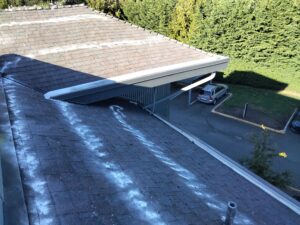Understanding Moss Inhibitor Products and Why Professionals Recommend Regular Application
Maintaining a healthy and clean roof is integral to the longevity and aesthetics of any home. A constant issue that many homeowners face is the growth of moss on their roofs, especially in the damp and shaded area of the PNW. Not only does moss detract from the visual appeal of your home, but it can also cause damage to your roof over time if left unchecked. Fortunately, there are effective solutions available in the form of moss inhibitor products.
Understanding Moss Inhibitor Products
Moss inhibitor products come in various forms, including sprays, granules, and concentrates. Each type has its own set of advantages and considerations, depending on factors such as the severity of moss growth, the type of roof material, and personal preferences.
-
- Sprays: Sprays are convenient for spot treatments or smaller roof areas. They often come in ready-to-use bottles, making them easy to apply without the need for additional mixing or equipment.
- Granules: Granular moss inhibitors are typically spread across the roof surface using a spreader or by hand. They offer broader coverage and can be effective for larger roof areas. Granules are formulated to dissolve slowly over time, providing long-lasting protection against moss regrowth.
- Concentrates: Concentrated moss inhibitors require dilution with water before application. This product typically takes a bit longer to use and requires more prep.
The Application Process
Regardless of the type of moss inhibitor product chosen, the application process generally follows these steps:
-
- Preparation: Before applying the moss inhibitor, it’s essential to clean the roof surface to remove existing moss, debris, and dirt. This can be done using a roof brush or pressure washer.
- Application: Follow the manufacturer’s instructions for the specific product being used. For sprays, ensure even coverage across the affected areas. Granules should be spread uniformly using a spreader or by hand, while concentrates require proper dilution and application with a sprayer or watering can.
Safety and Environmental Considerations
One of the primary concerns for homeowners when using moss inhibitor products is their safety, both for the roof and the surrounding environment. Fortunately, modern moss inhibitors are formulated to be environmentally friendly and safe to pets and humans.
These products typically contain ingredients that inhibit moss growth without posing harm to other life. Common active ingredients in moss inhibitors may include zinc sulfate, copper sulfate, or potassium salts. These compounds are biodegradable and have low toxicity levels, minimizing the risk to pets, wildlife, and vegetation surrounding the treated area.
Importance of Moss Inhibitor Application
Applying a moss inhibitor to your roof is not just about aesthetics; it’s also about protecting the integrity of your home. Here’s why it’s essential:
-
- Prevent Damage: Moss growth can compromise the structural integrity of your roof over time by trapping moisture, promoting decay, and causing shingle or tile damage.
- Extend Roof Lifespan: By inhibiting moss growth, you can prolong the lifespan of your roof, potentially saving you money on repairs or premature replacement.
- Maintain Curb Appeal: A clean and moss-free roof enhances the visual appeal of your home, increasing its resale value and leaving a positive impression on visitors.
Moss inhibitor application products offer an effective solution for preventing and controlling moss growth on roofs. By understanding the differences between product types, following proper application techniques, and prioritizing safety and environmental considerations, homeowners can maintain a clean, healthy, and long-lasting roof for years to come.
To read more about the different types of moss treatment see the link below!
https://bryophytes.science.oregonstate.edu/page24.htm




